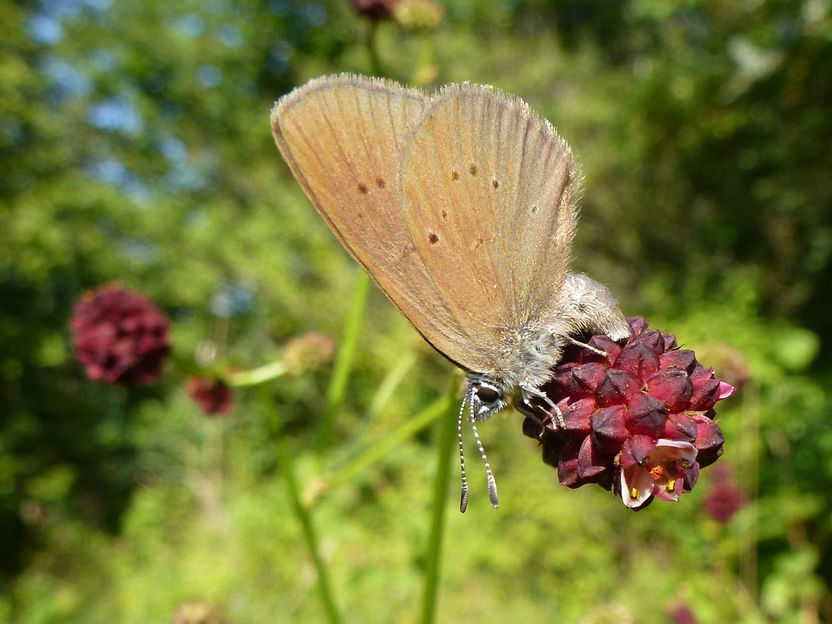Infected butterflies lead geneticists up the garden path
UFZ researchers illustrate the weaknesses of DNA barcoding
For animal species that cannot be distinguished using their external characteristics, genetic techniques such as DNA barcoding can help to identify cryptic species. An international team of researchers led by the Helmholtz Center for Environmental Research (UFZ) has brought out an article in the open-access journal PLOS ONE demonstrating how a bacterial infection can mimic cryptic speciation in butterflies. To avoid false results in the future, scientists recommend more in-depth genetic studies.

Phengaris nausithous (Dusky Large Blue): Female laying eggs on a great burnet flower head (Sanguisorba officinalis).
Josef Settele/UFZ
Some animal species look so alike that external characteristics do not provide sufficient information about whether they belong to the same species or not. "The animal species themselves on the other hand can certainly tell the difference, as it is crucial for their reproductive success", says Sylvia Ritter, PhD student from the Department of Community Ecology at the UFZ. In addition to external characteristics, odours and behaviour also play an important role. However, scientific investigations on species-specific odours and behaviour are very complex. "This is why for species that cannot be differentiated using standard methods, genetic techniques such as DNA barcoding are used", explains UFZ researcher Dr. Martin Wiemers. With DNA barcoding, certain sections of the mitochondrial DNA (mtDNA) are examined – that is the genetic makeup, which is not found in the nucleus of the cell, but located in the mitochondria which are the cell’s organelles residing in the cytoplasm. If divergences of more than two per cent are found between two potentially different species, then this is regarded as an indication of so-called cryptic speciation.
"Genetic studies of two parasitic butterfly species from the same genus of Large Blues suspect cryptic speciation, as great divergences were found in their mtDNA", says Wiemers. Together with Sylvia Ritter (first author of the article), the team supporting Martin Wiemers, Walter Durka, Josef Settele and Stefan Michalski has conducted studies on the Scarce Large Blue (Phengaris teleius) and the Dusky Large Blue (Phengaris nausithous) across their entire Eurasian distribution range. In addition to sections of mtDNA used in DNA barcoding, the researchers also compared nuclear DNA found in the nucleus of the cell. Furthermore, individuals were tested for infections with the so-called Wolbachia bacteria, as an infection with these bacteria can lead to the fact that the mtDNA of infected individuals will strongly differ from the mtDNA of non-infected Large Blues.
"We found very strong divergences in the mtDNA, which can be an indication of cryptic speciation. However, in the nuclear DNA markers there were no such differences, which would be near to impossible if we were dealing with different species", says Ritter. "We were able to find a significant correlation between the differences in mtDNA and Wolbachia infections. Hence, Wolbachia infections can be said to mimic cryptic speciation."
In some insect groups up to 70 per cent of all species are infected with Wolbachia bacteria. Up until now however there has been no standard testing for Wolbachia infections when DNA barcoding was carried out. "This could lead to cryptic species being found that do not actually exist. Particularly in the case of insects, we therefore recommend the additional testing of nuclear DNA so that investigations on cryptic species do not lead to false results. For species conservation it is also important to be able to differentiate between species because with their different characteristics they mostly have different habitat requirements", says Wiemers.
The Large Blues under investigation are particularly vulnerable species, since they not only depend on a specific food plant – the great burnet (Sanguisorba officinalis), but also on specific ant species. The larvae of these Large Blues feed on the eggs and larvae of these host ants and even adopt a „cuckoo strategy“ whereby they mimic the ants´ chemical substances in order to get the ants to feed them. Even the slightest changes in land use can lead to an absence in the necessary combination of food plant and host ants, causing the Large Blues to vanish from the ecosystem completely. According to Wiemers: "If we are to conserve a species, we first have to recognise what its needs are. A prerequisite for this on the other hand is to know which species we are dealing with. Only in this way can we proceed to implement meaningful measures for species conservation and species reintroduction programs."



















































